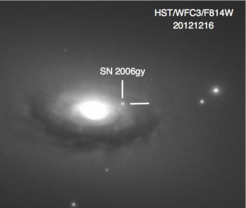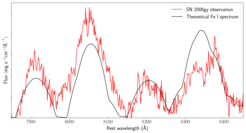Progress in understanding the brightest explosions in the Universe
Some unidentified features in one of the brightest stellar explosions ever witnessed, SN 2006gy, have now been explained by researchers at the Max Planck Institute for Astrophysics. The spectral lines arise from neutral iron - very unusual for such a high-energy event - and imply that more than a third of a solar mass of this heavy element was created. The dominance of iron in the spectrum rules out several previously proposed scenarios for SN 2006gy and instead opened up the door for a new one.
Superluminous supernovae are the brightest explosions in the cosmos. Over a few months they radiate as much energy as the Sun does over its entire lifetime, reaching a peak brightness exceeding that of an entire galaxy. The origin of this energy, and what kind of stellar progenitor system has exploded, are still unclear.

Image of the supernova SN 2006gy in the galaxy NGC 1260 about 6 years after the explosion was first observed. The supernova is still glowing brightly in the outer region of its host galaxy.
One of the most studied such objects is SN 2006gy, which was first observed in 2006. It showed signs of interaction between the supernova explosion and circumstellar material, which had been ejected previously. Many theories have been put forth for SN 2006gy, including collision of shells ejected subsequently by a very massive star, large amounts of radioactivity, or a massive stellar explosion called a core-collapse supernova, which arises when the compact core of a massive star collapses to a neutron star, interacting with its own wind.
In 2009, a Japanese research team presented observations, which showed a spectrum, i.e. the “rainbow colours” of the supernova a year after the explosion. This spectrum included peculiar emission lines that had never been seen before in any supernova and could not be identified. The origin of these lines and what their significance could be, remained a mystery for over a decade.
Researchers at the Max Planck Institute for Astrophysics (MPA), in collaboration with the Japanese team, have now been able to identify these lines as originating from neutral iron. “This low-energy state of iron is typically not seen in supernovae, where the high energies involved tend to strip one or several electrons from the atoms,” explains Anders Jerkstrand, from MPA and lead author of the new study. In addition, normally the supernova expands too fast for individual iron features to be clearly seen. “This particular set of lines has never been seen before in any kind of astrophysical nebula,” Jerkstrand adds. “SN 2006gy must truly have some unusual physical properties.”

That the spectrum mostly consists of iron excludes several previously suggested scenarios without iron. Further, the scientists determined that the iron mass amounts to at least a third of a solar mass, which surprisingly points to a Type Ia supernova. This type of supernova arises when a white dwarf remnant from a low-mass star accretes material and explodes.
The researchers propose that the progenitor system was a double star consisting of a white dwarf in a close orbit with a more massive hydrogen-rich companion star. As the hydrogen-rich star expanded its size - such giant stars can become as big as the Earth-Sun distance or even bigger - the white dwarf got trapped in the larger star’s atmosphere and spiralled in towards the center. In this process the envelope is ejected. Once the white dwarf reaches the core of the other star, it explodes. The expanding shock wave of this Ia supernova then collides with the previously ejected envelope, and in this gigantic collision extremely intense light is radiated. By modelling this light, the researchers could demonstrate that the suggested scenario reproduces the key properties of SN 2006gy - in particular including features of neutral iron.
“The results are significant in several ways”, says coauthor Keiichi Maeda from Kyoto University. “The origin of SN 2006gy as a Type Ia supernova turns upside down what most researchers have assumed, namely that this explosion came from a very massive star.” In a modern era where it is unusual that absorption or emission lines are not already known, the newly identified iron lines provide a new diagnostic method in astrophysics. Jerkstrand adds: “That a white dwarf can be in close binary orbit with a hydrogen-rich companion star, and quickly explode upon falling to the centre, gives important new information about the complex hydrodynamics of compact star explosions and for binary stellar evolution theory.”













